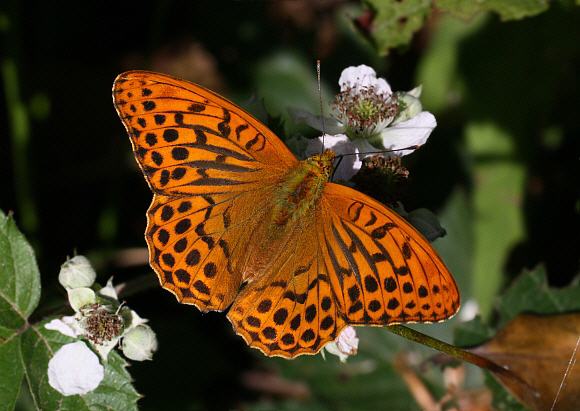
Silver-washed Fritillary Argynnis paphia male, Wiltshire, England – Adrian Hoskins
Introduction
The genus Argynnis comprises of about 25 species, found variously in Europe, temperate Asia and North America. Certain workers include an additional 18 Speyeria species within Argynnis.
The Silver-washed Fritillary is one of Europe’s largest and most magnificent butterflies. The common name refers to the suffused silvery markings on the underside hindwings. The male, shown above, is easily distinguished from the female by the 4 prominent horizontal dark streaks on its forewings. These contain androconial scales, from which pheromones are released during the courtship flight.
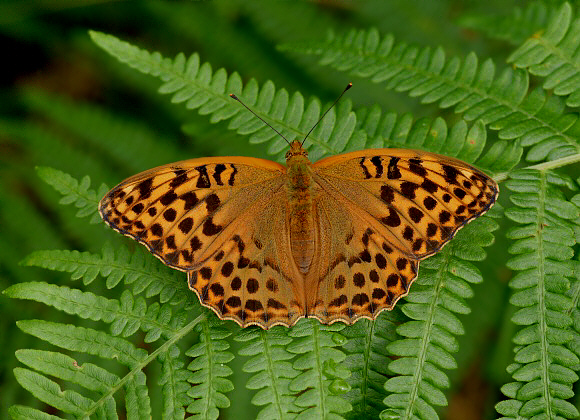 Silver-washed Fritillary Argynnis paphia female, Wiltshire, England – Adrian Hoskins
Silver-washed Fritillary Argynnis paphia female, Wiltshire, England – Adrian Hoskins
Females have a similar pattern of black spots, but lack the horizontal streaks. They are normally a dull golden colour, often with a slight bronzy tinge. The greyish female depicted below is the scarcer and very beautiful form valesina. It only occurs at a few sites, usually in long established colonies in oak forests. Captive breeding experiments have proven that about 10% of females in Hampshire, Wiltshire and Dorset are of the valesina variety. The numbers actually observed in the wild however are much lower as they are more secretive in behaviour than normal females. The common name refers to the suffused silvery markings on the greenish underside hindwings.
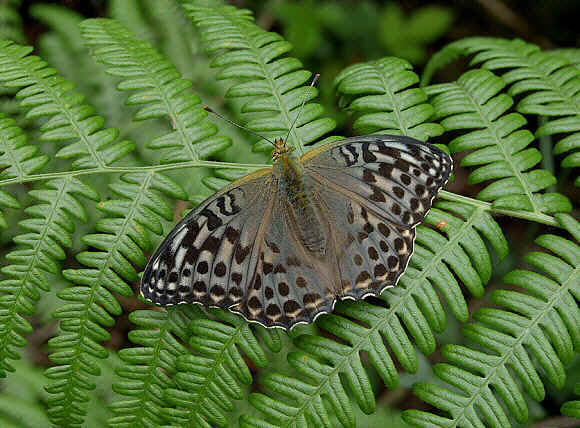 Silver-washed Fritillary Argynnis paphia female form valesina – Adrian Hoskins
Silver-washed Fritillary Argynnis paphia female form valesina – Adrian Hoskins
The butterfly is common and widely distributed across much of Europe, but absent from northern Scandinavia, northern Britain, and the southern parts of the Iberian peninsula. Beyond Europe it occurs in northern Algeria, and is widespread across temperate Asia to China, Korea and Japan.
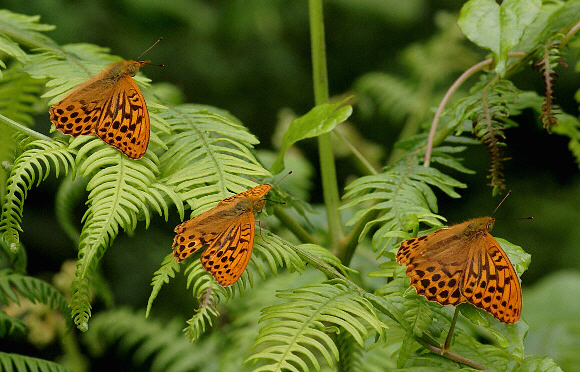 Argynnis paphia males basking on bracken in early morning – Adrian Hoskins
Argynnis paphia males basking on bracken in early morning – Adrian Hoskins
Habitats
The Silver-washed Fritillary prefers slightly shadier conditions than most other woodland Fritillaries and is better able to survive in high canopy forests and woods that have become neglected and overgrown. The highest populations occur in mature oak and beech plantations where a program of regular thinning encourages a profusion of dog violets to germinate beneath the trees. The best sites are also typified by having glades and grassy tracks where thistles, brambles and other nectar sources are abundant.
The butterfly is a powerful flyer and quite mobile, being often found on scrubby downland or along hedgerows or railway cuttings where these habitats are close to its woodland homelands. Thus it is able to recolonise neglected woods which have been thinned or returned to coppice management and once again become suitable as breeding sites.
In the early 19th century this species was found as far north as Dumfries, but has always been very scarce in northern Britain, and has been extinct in Scotland for about 150 years. There was however a freak migration in 1910, when the species found its way as north as Aberdeen. The butterfly is still very rare north of a line running from Liverpool to Peterborough, but has recently shown signs of expansion, probably as a result of climate change. In 2009 for example I found a fresh male Silver-washed Fritillary visiting bramble blossom in a wood near Witherslack in Cumbria.
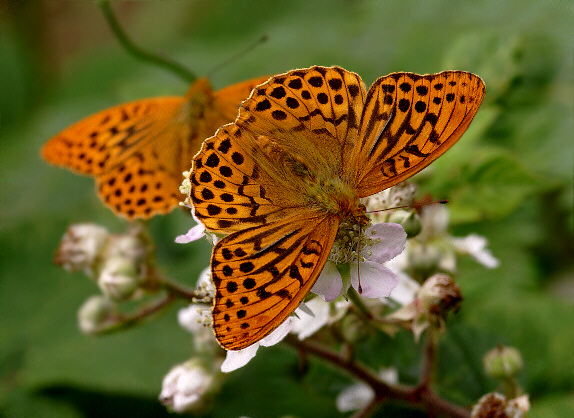
Silver-washed Fritillary Argynnis paphia males at bramble, Hampshire – Adrian Hoskins
Lifecycle
The butterflies emerge in June and July and have a life expectancy of about 3-4 weeks, although many are killed by birds before fulfilling their potential life spans.
The greenish-white eggs are laid singly in crevices in the bark of oaks, and more rarely on other trees including beech, ash and larch; normally at a height of about 2 metres, on the moss-covered east or north-facing side of the trees. The trees chosen tend to be about 50-100 year old specimens growing along the edges of rides, and illuminated by dappled sunlight. Often a female will revisit the same favoured tree trunk, laying a dozen or more eggs in the space of an afternoon.
Immediately after hatching in August, the tiny caterpillars eat their egg-shells, which contain vital nutrients. They then attach themselves to a little pad of silk which they spin on the tree trunk, and enter a state of diapause, remaining hidden in a chink in the bark until the arrival of sunny weather in March of the following year. They then descend the trees and wander in search of dog violets Viola riviniana. They feed diurnally, eating only the lobes of the violet leaves, and then move on to another plant. The fully grown larvae can sometimes be found basking on dead oak leaves in May or early June. They are black, marked with a double yellow line along the back, and have a series of dull orange branched spikes on the back and sides. The 2 spikes on the first segment are black, and inclined forward over the head.
The slightly spiky pupa is mottled in shades of brown, and decorated with golden spots. It is almost impossible to find in the wild, but is reportedly suspended by the cremaster from the woody stems of bushes, or from twigs on oak trees. The pupal stage lasts for about 3 weeks.
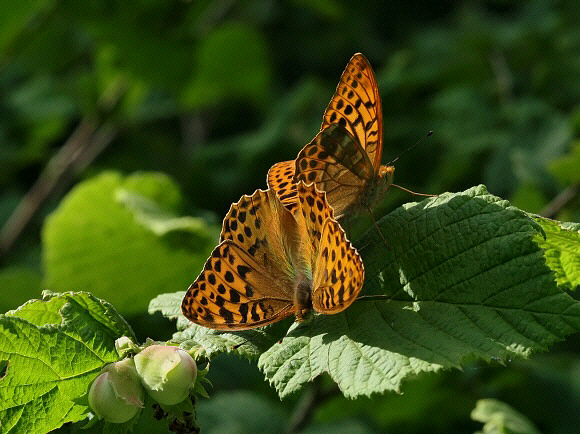
Silver-washed Fritillary Argynnis paphia, Hampshire – Colin Baker
Adult behaviour
The first males emerge in late June, appearing about a week before the first females. Individuals can live for up to a month, with worn specimens seen as late as early September.
Overnight, and during dull weather, the butterflies roost amongst oak leaves high in the tree tops. In the early morning they bask high up until the rays of the sun reach the forest floor, and then drift down to continue basking on bracken, hazel leaves, and other low vegetation.As the day warms up they become more active, nectaring avidly at thistles, bramble blossom, hemp agrimony, hogweed and ragwort. Both sexes also imbibe honey-dew from the surface of leaves, and males often settle on stony tracks to imbibe mineral-rich moisture.
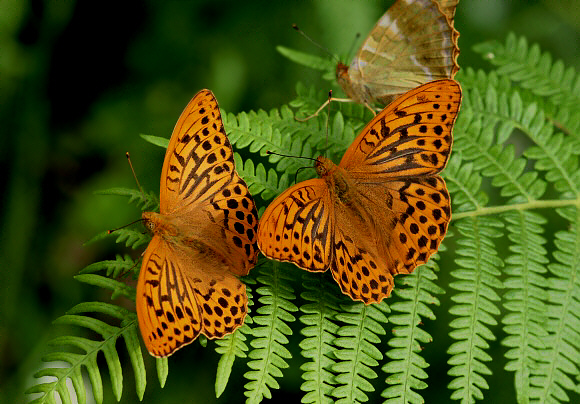
Silver-washed Fritillary Argynnis paphia males, Wiltshire � Adrian Hoskins
The courtship ritual of the Silver-washed Fritillary is one of the most endearing and familiar sights of the English summer. The female flies in a straight line along woodland tracks at a height of about 2 metres, and as she does so she emits an aphrodisiac scent from the tip of her abdomen. The male responds by following her closely, repeatedly looping under and over her, and showering her with pheromones released from the 4 black bars of androconial scales which run along the veins of his forewings. In many cases this tantalising display fails to entice the female into mating, but if she is receptive she leads the male to a clump of leaves high in an oak tree where copulation takes place. Periodically the pair fly down to settle on bracken or hazel, or to nectar at bramble, but return to the tree tops if disturbed. Copulation lasts about 2 hours and usually takes place in late morning.
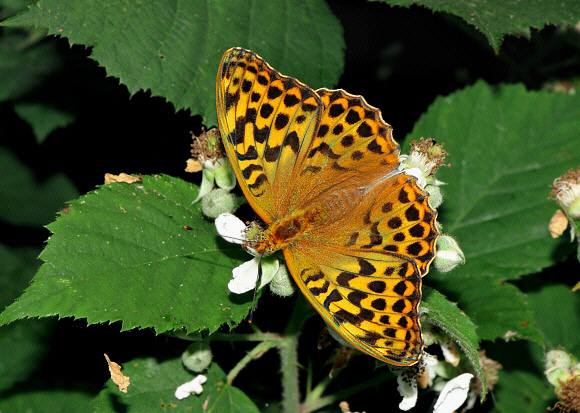 Silver-washed Fritillary Argynnis paphia female, Straits Inclosure, Hampshire – Adrian Hoskins
Silver-washed Fritillary Argynnis paphia female, Straits Inclosure, Hampshire – Adrian Hoskins
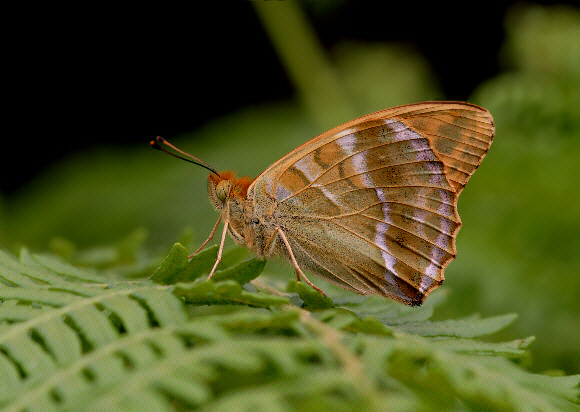 Silver-washed Fritillary Argynnis paphia male, Bentley Wood, Wiltshire – Adrian Hoskins
Silver-washed Fritillary Argynnis paphia male, Bentley Wood, Wiltshire – Adrian Hoskins
